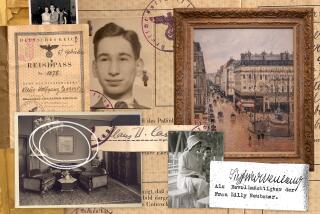Hoarder of suspected Nazi-looted art: I won’t ‘give back anything’
- Share via
“I won’t voluntarily give back anything.”
So said Cornelius Gurlitt, who was revealed to be holding more than 1,400 possibly Nazi-looted works of art in his Munich apartment, in his first interview since the bombshell discovery was made public in late October.
The art dealer spoke to the German newspaper Der Spiegel, claiming that he had nothing to do with the acquisition of the art, which many believe was improperly acquired by the Nazis during World War II.
The interview, which was published Sunday and is available in English translation, comes at a time when experts are sorting through the massive stash in an attempt to verify and authenticate the many paintings, drawings and other pieces that were crammed in Gurlitt’s apartment.
Bowing to international pressure for more transparency in the case, authorities in Germany began publishing a preliminary online list of the pieces last week. Officials made the discovery in 2012 but kept the art cache under wraps until the German magazine Focus broke the news last month.
ART: Can you guess the high price?
In the interview, Gurlitt claimed that “I never had anything to do with acquiring the pictures, only with saving them.”
He said he helped his father -- the Nazi art dealer Hildebrand Gurlitt -- to save the works of art from the Russians as they moved deeper into Germany. “My father knew the Russians were getting closer and closer,” he said.
Gurlitt claimed that his father quickly arranged for a vehicle and that they loaded the artwork inside. He said his father then brought it all to a farmer near Dresden, and later to a castle in southern Germany.
“I’m not as courageous as my father,” Gurlitt said. “He loved art and fought for it. The state prosecutor has to restore my father’s reputation.”
The Der Spiegel interview took place primarily on a high-speed train that Gurlitt was taking to visit a doctor in the south of Germany. The article portrays the 80-year-old art dealer as a virtual recluse, having spent most of his time with his art work, with little connection to the modern world.
Experts believe that some of the art may have been acquired from Jewish families during the Holocaust, and that other pieces could be art that German museums were forced to deaccession under the Nazis’ “degenerate art” policy.
“I hope everything will be cleared up quickly, so I can finally have my pictures back,” Gurlitt said.
ALSO:
Lift the veil from the Nazi art cache
Details emerge of masterpieces in Nazi art trove
Germany begins releasing list of works from Nazi art stash
More to Read
The biggest entertainment stories
Get our big stories about Hollywood, film, television, music, arts, culture and more right in your inbox as soon as they publish.
You may occasionally receive promotional content from the Los Angeles Times.











